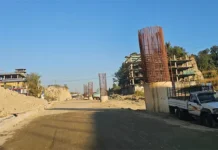[ Dr Amit Kumar Singh & Dr Lobsang Jampa ]
The coronavirus disease-2019 (Covid-19) pandemic started its journey from our neighbouring country China and affected almost 213 countries, including India. It is caused by a virus known as Severe Acute Respiratory Coronavirus Syndrome 2 (SARS-CoV-2).
Till now it has affected approximately 8 million people and caused almost 4 lakh deaths worldwide. In India, the total number of cases is now more than 3 lakhs, with approximately 52 percent recovery rate.
In Arunachal, around 15000 samples have been tested and 95 cases detected. All these data we have with us are because of a technique known as real time reverse transcription-polymerase chain reaction (RT-PCR), which is basically
a nucleic acid amplification test. It is a highly specific and sensitive test, and is considered as ‘gold standard’ in the diagnosis of Covid-19. It is a recommended method for the diagnosis of Covid-19 by the World Health Organization (WHO) and the Indian Council of Medical Research.
RT-PCR detects a set of specific genes of the virus, called target sequences, in the samples by a process called amplification. This test is designed to detect the genes specific to SARS-CoV-2 and can detect as low as 20 viral copies per microlitre of sample. The test has got several steps, starting from extraction of viral RNA from the sample to a chain reaction inside a real-time PCR machine.
Inside the machine, cycles of chemical reactions occur, which doubles the amount of target sections of the virus every cycle and produces around 35 billion new copies in approximately one hour.
The test is always performed using internal and external quality controls to ensure that the result should be valid. In addition, to verify the adequacy of the collected sample, a particular human gene is also detected.
As none of the diagnostic method is infallible, there are certain limitations in this technique too.
As per the WHO, the test may lead to a negative result in an infected individual owing to a number of factors, such as poor quality or quantity of sample, timing of sample collection (either very early or too late in infection), improper handling of sample during transportation, presence of inhibitors of PCR, and mutation in the target regions of the virus.
However, the test is designed to overcome most of its limitations. Studies also suggest that the most appropriate sample for diagnosis is sputum, followed by nasopharyngeal swab and oropharyngeal swab. But approximately 80 percent cases are either without any symptoms or with mild symptoms, so sputum production is uncommon and thus affects the sensitivity of the test.
The RT-PCR is truly a saviour in the era of Covid-19 pandemic as it is a rapid, highly sensitive and specific diagnostic method and provides the needed support during this pandemic.
Moreover, it is the only technique at present which can test a large number of samples in a limited amount of time. (Dr Singh is Associate Professor (Microbiology), TRIHMS, Naharlagun, and Dr Jampa is State Nodal Officer for Covid-19.)




